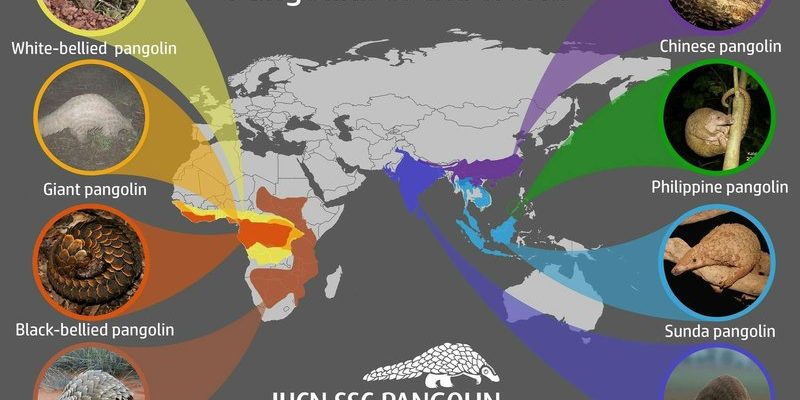
Pangolins are among the most trafficked mammals in the world, primarily due to their scales, which are used in traditional medicine and as a delicacy in some cultures. Understanding where they live—along with what their ideal environment looks like—can help raise awareness about their conservation needs. So, let’s dive into the world of Indian pangolins and discover their home sweet home.
What Is the Habitat of Indian Pangolins?
When we talk about the habitat of Indian pangolins, we’re referring to the specific type of environment where they feel most at ease. Indian pangolins primarily thrive in tropical and subtropical forests, grasslands, and scrublands. They prefer areas where they can easily find their main food source: ants and termites.
These charming creatures are nocturnal, meaning they’re active at night and tend to stay hidden during the day. They often make their homes in burrows or under leaf litter, which provides excellent cover. It’s like having a secret fort where they can retreat when they feel threatened. So, when you picture their habitat, think of a warm, leafy forest filled with plenty of insects for dinner!
Geographic Distribution of Indian Pangolins
Indian pangolins can be found in various regions across the Indian subcontinent. They’re primarily located in:
- India: Their most extensive range is here, especially in central and northern India.
- Nepal: They inhabit the Terai region, which is rich in grasslands.
- Bangladesh: Like in India, they prefer forested areas that offer plenty of food.
- Sri Lanka: You might find them in wildlife reserves and forests.
- Myanmar: Their presence extends into parts of Southeast Asia as well.
You might be wondering what factors affect their distribution. Well, it largely depends on the availability of food, suitable climate, and shelter. Urbanization and deforestation are serious threats that can shrink their habitats, making it crucial to conserve the areas where they live.
Climate Preferences of Indian Pangolins
Climate plays a significant role in determining where Indian pangolins can thrive. They tend to prefer warm and humid environments. A tropical climate, with temperatures ranging between 20°C to 30°C (68°F to 86°F), is ideal for them.
These conditions help maintain the populations of ants and termites that they depend on. They’re not fans of extreme cold, and prolonged chilly weather can drive them into hibernation or even lead to population declines. So, if you’re thinking about finding a pangolin, you’ll have better luck in regions where the weather is consistently warm and humid.
Threats to Their Habitat
Unfortunately, Indian pangolins face numerous challenges in their natural habitats. Here are some of the main threats they encounter:
- Deforestation: As humans clear forests for agriculture and urban development, pangolins lose their homes.
- Illegal Wildlife Trade: Pangolins are heavily trafficked for their scales and meat, putting immense pressure on their populations.
- Climate Change: Altered weather patterns can affect their food supply and habitat suitability.
Each of these threats has a domino effect, disrupting the balance of ecosystems. This is why conservation efforts are so vital. Protecting their habitats not only benefits pangolins but also the rich biodiversity found in those ecosystems.
Conservation Efforts for Indian Pangolins
Many organizations and governments are stepping up to protect Indian pangolins and their habitats. Here are some key initiatives:
- Legal Protection: Indian pangolins are protected under the Wildlife Protection Act of 1972. This law makes poaching and trafficking illegal.
- Awareness Campaigns: Many NGOs work tirelessly to educate the public about the importance of pangolins and the threats they face.
- Habitat Restoration: Various programs are focused on restoring and preserving natural habitats, creating safe spaces for these creatures to thrive.
These efforts are crucial for the survival of Indian pangolins. Being informed and supportive can make a significant difference in their conservation.
How to Spot an Indian Pangolin in the Wild
If you’re lucky enough to explore their habitats, you might want to keep an eye out for Indian pangolins. Here are some tips for spotting them:
1. Look for Burrows: Check for small holes in the ground or beneath tree roots. These serve as their homes.
2. Listen for Sounds: Pangolins may rustle through leaves while foraging at night. Their movements can give them away.
3. Track Their Scales: You might come across discarded scales or tracks in the mud, hinting at their presence.
While they can be elusive, with a bit of patience and the right conditions, you might just catch a glimpse of these enchanting creatures in their natural setting.
To wrap it all up, Indian pangolins are more than just unique animals; they play a vital role in their ecosystems. Their habitats are becoming increasingly threatened, which makes understanding where they live all the more important. By learning about their needs and the threats they face, we can become better advocates for their conservation.
So the next time someone brings up pangolins, you can share not just where they live but also why protecting these incredible creatures matters. Together, we can work towards a world where Indian pangolins continue to thrive in their natural habitats for generations to come.

